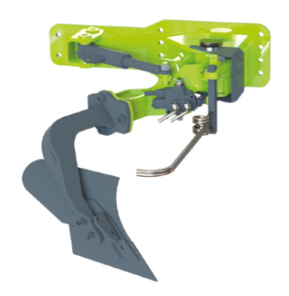Background
Several different tools are used by wine-grape growers across Australia to manage under-vine weeds without chemicals.

Figure 1. FMR interstock plow (image courtesy of FMR)
Most growers use a combination of equipment to achieve good weed control. Cultivation is commonly used for non-chemical weed control, and the dodge plough (Figure 1) is still used as an aggressive tool for hard-to-control weeds.
Action
A dodge plough breaks up the soil and turns it over, moving soil from under the vine to a mound away from the vine. A second cultivation pass later in the season, usually with a disc, returns the soil under the vine, rebuilding the mound and smothering many weeds in the process. The loosened soil that results from a dodge plough pass, is well suited to further weed control with other secondary cultivation tools (e.g. finger weeder, knife weeder).
Advantages and disadvantages
Advantages: Dodge plough provide very effective weed control for otherwise hard to remove species and can help to break up hard, compacted soil.
Disadvantages: Dodge ploughs are slow and aggressive cultivation tools the require good operator experience to avoid damage to vines. They can damage soil structure and reduce soil carbon levels if used in soils that are too dry or wet. Repeated passes are required for long-term weed control. Under-vine cultivation can cause reductions in vine vigour in the first two years until the vine roots adjust by moving deeper into the soil profile. Can spread couch and kikuyu.
Table 1. Advantages and disadvantages of a dodge plough
| Ability to reduce weed competition with vines | Good |
| Soil disturbance caused | Poor |
| Suitability in young vineyards | Poor |
| Length of weed control | Good |
| Operating speed | Poor |
| Operating cost | High |
| Capital cost | Average |
Considerations
When considering which weed control tools to use, it is important to base the decision on each vineyard’s individual characteristics. Factors such as soil type and condition; slope; rainfall and water availability; weed pressure; vine age; vine vigour; fruit end-use targets; weather conditions; and compatibility with existing infrastructure and equipment should all be considered.
Table 2. Ease of using a dodge plough on different soil types
| Large or excessive stones | Difficult |
| Stone/gravel | Ok |
| Sand | Easy |
| Silt/loam | Easy |
| Clay | Ok* |
*Can be difficult in wet or very dry soils
Cultivation tips
- Control weeds when they are small.
- Any mechanical weed control operation is most effective in hot, dry weather with dry soils.
- Cultivation may be damaging to soil in very wet or very dry conditions.
- The first cultivation pass may pull up rocks. Remove large rocks manually.
Growers’ experiences
Handpicked Wines in the cool climate region of the Yarra Valley uses a dodge plough to clean up hard woody weeds such as mallow that are left behind by less aggressive cultivation tools such as the finger weeder and knife weeder.
Resources
Organic Winegrowers New Zealand. 2017. Undervine weed management – A practical guide to effective weed control in organic vineyards.
NSW Agriculture. 1993. How cultivation affects soil.
Contact
For further information, please contact:
AWRI helpdesk
Phone 08 8313 6600 Email helpdesk@awri.com.au

